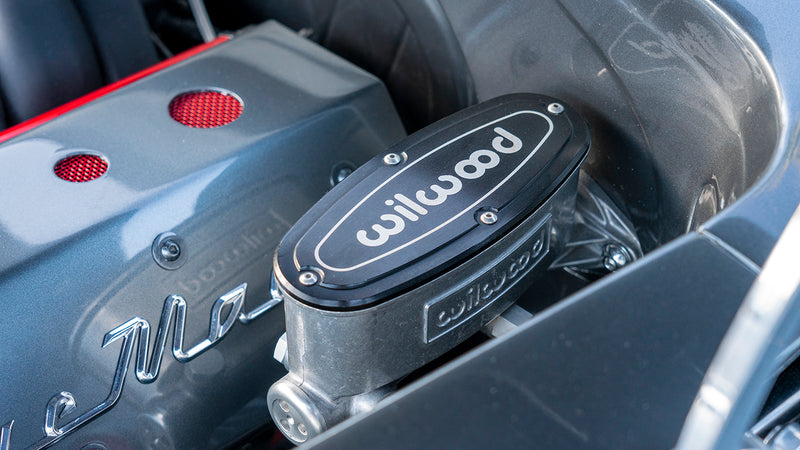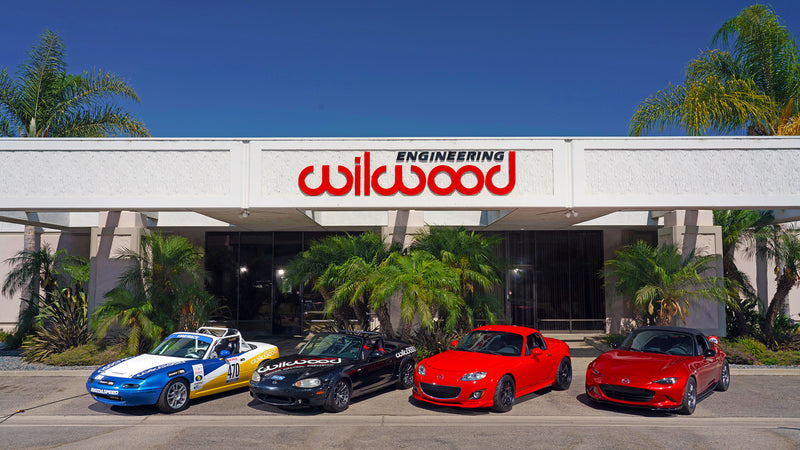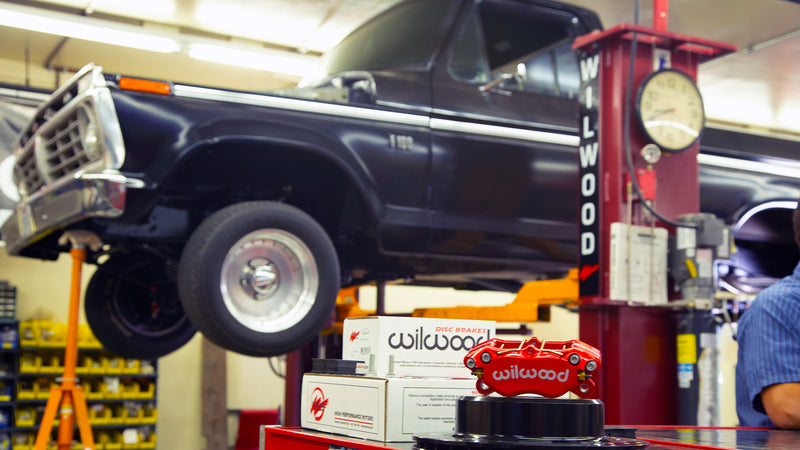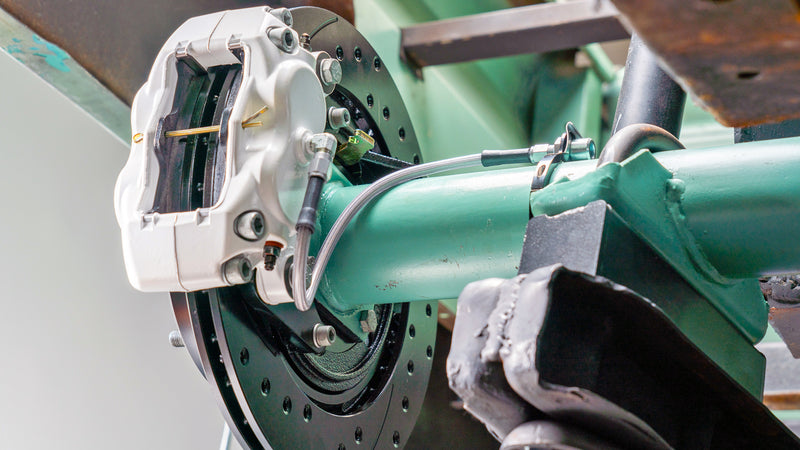
Some common complaints to our tech line include not getting any fluid to the rear wheel calipers, no pressure in the rear lines, or trouble bench bleeding the rear port of the master cylinder. With a dual circuit/tandem master cylinder (M/C) all three issues can have the same cause - the rear (closest to the mounting flange) piston not fully returning to its proper resting position. Customers often think they have a defective M/C, or one that does not move enough fluid volume, but that’s not the problem.
For the M/C to pump fluid and build pressure properly, the piston's primary seal must retract past the compensating port, and the rear of the piston rest on the snap ring (or pushrod rest on the washer for M/C with attached pushrods). In the diagram, you can see the seals for both the front and rear circuits return to the proper position, just behind the compensating port. The pushrod and washer are at rest against the snap ring, which keeps the piston from coming out the back of the cylinder bore.

This problem occurs only in the rear brake circuit because of a spring between the two pistons in the M/C. The front piston will begin its travel slightly after the rear, once the spring compresses, and can return to rest properly even if the rear does not fully return.
If the seal doesn’t retract past the port, the cylinder bore doesn’t refill, and whatever fluid is pushed into the brake line is sucked back out. If the M/C doesn't pump, the rear brake circuit doesn't get any fluid, you can't bleed the rear calipers, and they won't clamp when you step on the brakes.
If you have any of these situations, check that the piston is resting against the snap ring/pushrod retention washer when the pedal is at full rest. When the pushrod is not attached to the M/C, it’s easy to tell if the piston isn’t seated against the snap ring (on non-power brake cars) by looking up under the dash where it comes through the firewall. Or if you can't see it, you should be able to reach up and easily jiggle the pushrod around with it connected to the pedal.
Here are some common things that cause this problem:
- Installing a pushrod and retaining washer on a M/C without one.
- Removing a pushrod and retaining washer from a M/C.
- Failure to adjust the length of the old pushrod to the new M/C.
- Extending the pushrod too far for a higher pedal height.
- Reducing pushrod free play so the brakes grab quicker.

When using a vacuum booster or hydro-boost unit, the pushrod must be adjusted correctly and typically is threaded to allow adjustment. If it is too short, you can use the proper-sized Wilwood aluminum bullet spacer to make it longer if necessary. If you make your own or re-use a factory pushrod, the head of the pushrod must be no larger than 3/8" diameter with a rounded end to fit in the piston.
When installing the M/C on a booster or hydro-boost, if you feel resistance before the mounting flange is touching the unit, or you have to tighten the mounting nuts to pull it tight to the booster, the pushrod is too long. A good way to check, before adding any fluid, is to remove the fountain cover in the reservoir, and look down to see if the piston moves past the port when you tighten the nuts. Another way to check is to dab some grease on the end of the pushrod, tighten the mounting nuts and see if the grease shows signs of touching the piston, and adjust accordingly until it doesn't touch.
Installing washers between the booster and the M/C flange until there is sufficient play can give you an idea of how much the pushrod needs to be shortened. However, using washers between the mounting flange and the unit is absolutely not the way to fix it. The pushrod must be shortened, and the M/C bolted securely and directly to the booster for the proper, safe operation of the brakes.
For manual brakes, Wilwood recommends using a M/C that comes with a pushrod already installed and connecting that to your pedal. This is the easiest way to get a pushrod that is the proper length with the correct amount of free play.
If the problem comes on suddenly, after the M/C has been in use, it could be a pedal that is not adjusted correctly. Some brake pedal assemblies have an adjustable stop under the dash which if adjusted wrong can keep the pushrod from fully returning. On vehicles with a brake light switch that comes in contact with the brake pedal arm, the problem can be as simple as the switch being adjusted or installed improperly.
In the end, it doesn't matter why the piston is not fully returning to rest against the snap ring. Getting the rear brake circuit to function correctly depends on that piston getting back where it belongs after every application of the brakes.





Jayrome,
We get calls all the time on our tech line with similar issues. They have a whole list they will go through with you to try to determine what the problem is. It usually is not a bad master cylinder.
I forwarded this to them, but you will get a faster answer by calling (805) 388-1188, 6am-5pm Pacific Time, Monday to Friday.
We have recently installed one of your manual boosters and cannot get pressure build up the piston returns to the washer as it should bottoms out as it should we have bled the lines the master cylinder and calipers to no avail still no pressure. We also removed the cap and noticed that pistons on the inside do move but when u let off the peddle lots of fluid returns to the cylinder any info would be greatly appreciated
You are correct. When you install the master cylinder on the brake booster, hydroboost, or just to the pedal pushrod, there needs to be no pressure on the piston. There doesn’t need to be much play in the pushrod, but it should be free to account for heat expansion and any play in the system. As suggested in the blog post, try mounting the master cylinder with a washer or two behind it to space it out and see if that helps. Then modify or adjust the pushrod to get the play needed.
Yes, check that the pedal isn’t hanging up sometimes on the stop or brake light switch.
I am not that familiar with the hydroboost system, but I would also try starting the motor and see if the pushrod moves at all when the pump pressurizes the system.
So if I understand this correctly when you mount the flange to the firewall there should be no pressure pushing in on the piston for the master cylinder correct? I’m looking up a hydro boost to one of your master cylinders and have them the problem of no fluid to the rear brake system.I am to check the brake light switch and pedal return position and it just as necessary? Thank you for any input you may have, appreciate it. Wolfe
Gaurav,
There should be no “dead zone” in our master cylinder when set up and bled properly. You may not be able to feel the pressure building until your foot has traveled some distance, but it should be building pressure on a gauge nearly instantly.
When you depress the pedal, the vehicle’s brake system should be immediately activated. If it’s not, diagnosing the situation requires more information.
I recently bought a Wilwood TM1 for a custom single seater offroad race car. When bleeding the master cylinder, there is a bit of a dead zone (about 0.5 in) in the master cylinder before any brake pressure builds. Is there any reason for this? Is that deadzone built into the master cylinder for some reason? I am fairly confident the system has no air in it, as when I do get past the deadzone, the front and rear brakes work flawlessly.
Thank you
Jay,
Typically the boot stays on in manual brake applications where the pushrod comes with the master cylinder. Power brake boosters are all different and on some you may not be able to use the rubber boot, or you may be able to use it but not need it. The boot is not intended to hold the pushrod in place, just to keep dust out of the master cylinder.
Bryan
Does the rubber boot stay on the master cylinder when installed or it depending on application ?
Thank you very much.. Got me out of a tough spot!!!